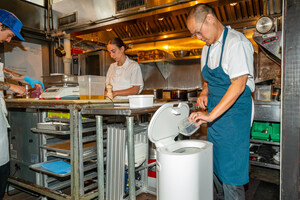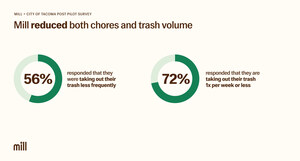Following Food and Drug Administration (FDA) recommendation earlier this summer, Association of American Feed Control Officials (AAFCO) Committee votes unanimously to advance new animal feed ingredient definition that will allow kitchen scraps to be processed into food for chickens
Move by AAFCO and FDA enables new pathway to keep nutrients in the food system and prevent household food waste, the #1 contributor to food in landfills and a major greenhouse gas emitter
SAN BRUNO, Calif., Aug. 10, 2023 /PRNewswire/ -- Mill, a first-of-its-kind home food-recycling service, announced an important milestone in its mission to make it easy for people at home to send food back to farms, instead of landfills: last week a new animal feed ingredient definition for Dried Recovered Household Food received a unanimous vote of approval from the Association of American Feed Control Officials (AAFCO) Ingredient Definition Committee. The vote follows a recommendation from the Food and Drug Administration (FDA) earlier this summer.
The new animal feed ingredient definition unlocks a historic new regulatory pathway to conserve nutrients and keep household food in the food system by feeding it to poultry. Although the new definition still needs to clear two procedural votes later this year before its expected inclusion in the AAFCO Official Publication (OP) in January 2024, the committee vote and FDA recommendation were the most rigorous regulatory reviews required and demonstrate significant confidence in and momentum around the definition.
Historic vote marks a significant step in tackling the problem of food waste and its impact on the planet and supporting more sustainable agriculture practices
According to Project Drawdown, reducing food waste is one of the largest opportunities to reduce greenhouse gas emissions over the next 30 years. Moreover, over 30% of the world's croplands are used to grow animal feed, and the production of animal feed represents a significant amount of livestock-related emissions.
This move by AAFCO and FDA is well aligned with recommendations from organizations such as the Zero Food Waste Coalition to recycle food scraps into animal feed and has broad, positive climate implications across the US: for policymakers and government leaders looking to tackle the problem of food waste in cities, for farmers pursuing more sustainable feed options, and for people who want to prevent food waste at home. Animal feed is broadly considered a preferred end use for recovered food, including by the Environmental Protection Agency (EPA), and is recognized as a compliant end use in California's landmark SB 1383 organics program.
Today, restaurants and grocery stores are sending uneaten food back to farms to feed poultry, enabled by AAFCO definitions and existing circular infrastructures. But a regulatory pathway for uneaten food from households hadn't existed until now due to the lack of a viable model to ensure the safety, quality, and consistency of food in homes at scale, or one that enables safe source separation at the household level easily, or an efficient system to get that resource back to farms.
"This historic new pathway isn't just good news for Mill, it's a win for the broader industry and the planet: recycling uneaten household food into animal feed offers a scalable new way to more sustainably feed the growing global population while slashing methane emissions," said Harry Tannenbaum, Cofounder and President at Mill. "The new poultry feed ingredient definition unlocks a massive opportunity to prevent waste, conserve nutrients and reduce emissions—and allows Mill to offer a truly closed-loop service to customers, and an alternative, safe, nutritious, and consistent feed ingredient for farmers. We are grateful for the thoughtful, rigorous, and effective collaboration with regulators, and give AAFCO and FDA a lot of credit for recognizing the state-level interest and momentum in preventing waste and getting recovered household food to a higher and better use."
Mill's food-recycling service makes this new pathway possible for people at home
Today, Mill is the only company that offers a service that can deliver on the definition that the AAFCO Ingredient Definition Committee voted on, and opens up the potential for all dried recovered household food in the U.S. to be turned into a feed ingredient for poultry.
Building upon the Mill team's experience in creating products that encourage new habits at home that are good for people and the planet, Mill's food-recycling service is easy and convenient and already in the homes of people across the country.
How Mill works:
- Customers toss uneaten and unspoiled kitchen scraps into Mill's connected kitchen bin, which includes sensors, scales, algorithms, and drying technologies that weigh and dehydrate food scraps to less than 12% moisture content overnight. The resulting material is called Food Grounds.
- Once the kitchen bin is full—which takes a few weeks—Food Grounds are picked up from customer doorsteps and sent to Mill's first feed facility in Mukilteo, Washington.
- Upon arrival in Mukilteo, Mill runs a series of processing steps, including inspection, screening, microbial control, and more, to ensure the collected materials can be safely turned into food for chickens.
- By blending together a variety of different households' Food Grounds, Mill obtains a sufficiently consistent product for poultry farmers and their nutritionists, who prescribe the final complete feed product.
Customers who sign up for the Mill service receive:
- A new type of connected kitchen bin that dehydrates food scraps overnight;
- Access to a robust educational food library that provides feedback and training on what food items are suitable for the lockable bin;
- Everything required to send Food Grounds back for processing (including boxes, liners, and postage); and
- Household-level impact and feedback reports on the quality and quantity of Food Grounds customers send to Mill's feed facility.
Mill maintains a direct relationship with its customers, and can trace each box of Food Grounds back to the relevant household. All of the technology, processes, and controls embedded in the end-to-end Mill service contribute to the creation of a safe and consistent poultry feed ingredient.
About Mill Industries Inc. ("Mill")
Trash stinks. Together, we can do better. Mill has created a new system to help you outsmart waste at home. Learn more here.
Mill was founded in 2020 by Matt Rogers and Harry Tannenbaum, who worked together at Nest, building the iconic Nest Learning Thermostat and other smart home products. The lessons they learned about encouraging new habits at home that are good for people and the planet were applied in creating Mill to change our perception of waste, starting in the kitchen.
Mill and Food Grounds are trademarks of Mill Industries Inc.
Follow Mill
Instagram, Facebook, and Twitter
The Association of American Feed Control Officials (AAFCO) is an independent organization that has been guiding state, federal and international feed regulations with ingredient definitions, label standards and laboratory standards for more than 110 years, while supporting the health and safety of people and animals. Members are charged by their local, state or federal laws to regulate the sale and distribution of animal feeds and animal drug remedies.
SOURCE Mill Industries Inc.

WANT YOUR COMPANY'S NEWS FEATURED ON PRNEWSWIRE.COM?
Newsrooms &
Influencers
Digital Media
Outlets
Journalists
Opted In






Share this article